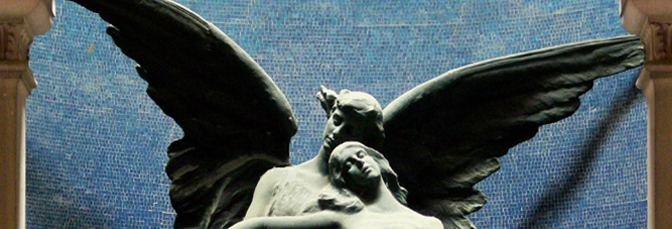Museo Civico del Risorgimento
Piazza Carducci 5
40125 Bologna
tel. +39 051 347592 (reception and ticket office)
Offices
Via de' Musei 8
40124 Bologna
tel. and fax +39 051 225583
e-mail
Library of Museo Civico del Risorgimento
Via de' Musei 8
40124 Bologna
tel. and fax +39 051 225583
e-mail
Certosa
Via della Certosa 18
40133 Bologna
tel. and fax +39 051 225583
e-mail

Unlike many Italian monumental cemeteries, which were built from scratch, the Bologna cemetery was created by reutilizing the structures of the pre-existent monastery of San Girolamo di Casara.
Even though nowadays it appears fully integrated into the urban fabric, it was chosen in 1801, as it became usual for the other European cemeteries after 1804, rightly because of its distance from the residential area and for the opportunity to adapt it by way of very few works. Starting from 1797, year of its suppression, the monastic building underwent many transformations, demolitions and extensions, so that the original structure is only partially visible.
Already in 1801, the fence to the north of the cemetery was built and decorated with terracotta sculptures by G. Putti, where a new monumental entrance was opened.
The first works were readjustments of the monastery spaces, whilst from 1833 the building programme was the result of a more complex structure, with exedrae, biaxial elements, symmetries aimed at a greater monumental ambition.
Between 1816 and 1834 the main rooms of the Certosa were built: in 1816 the ’Hall of the Graves’, in 1833, the ’Arcade of the Graves’ and, immediately after, the ’Gemina Hall’ and the ‘Colombario’, an impressive building with three naves inspired by the Roman thermal architecture. The building of the ‘Elliptical Hall’, a small body to connect the nineteenth and twentieth-century group, dates back to 1834, while in 1860 the previous ‘Chapel of the Suffrages’ was turned into the ‘Gallery of Angels’. Soon after this last one, the ‘Three-Aisled Gallery’ was built, connecting the structures built until then.
In this period was discovered an Etruscan Necropolis (between 6th and 5th century b. C.) under the structures of the monastery. With these excavations began the discovery of the ancient history of Bologna.
A different interpretation of the spaces started at the beginning of the twentieth century, according to a more monumental and rhetorical viewpoint: significant examples of this period are the ’Sixth Cloister’ with the ‘World War I Memorial’, the ‘Eighth’ and the ‘Ninth Cloister’, with the annexed galleries. In 1924, the new entrance was built, at the end of the colonnade, near the Reno canal.
Along these spaces of the cemetery, visitors can admire an impressive repertory of monuments, unique in Europe. The most ancient works are showed on the walls of the Third Cloister and are mainly frescoes belonging to the most important and distinguished Bolognese families. Only later, the graves started to be decorated with sculptures and different decoration bodies that, until the mid of the nineteenth century, were composed by ‘poor’ materials, such as plaster, stucco, scagliola or terracotta and only afterwards, marble and bronze. Over 80 painters, sculptors and architects work in to the cemetery, creating an open museum of XIX and XX century.
In the Certosa cemetery are buried many important people for town's and italian history, including the statesman Marco Minghetti, painters Giorgio Morandi and Bruno Saetti, the Nobel poet Giosue Carducci, the writer Riccardo Bacchelli, the opera singer Carlo Broschi Farinelli, the music composer Ottorino Respighi, the polish army general Joseph Grabinski and prime minister Taddeus Matuszevic, the founders of Maserati, Ducati and Weber industries, the publisher Nicola Zanichelli.
The Certosa was the destination of the visitor in Bologna throughout the nineteenth century: Lord Byron, Jules Janin, Charles Dickens and Theodor Mommsen write about their visit in the cemetery.
Our database online, only in Italian language:
www.storiaememoriadibologna.it